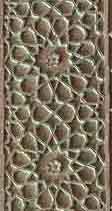FURTHER
RESOURCES:
ONLINE
BOOKS:
*Carl Ernst, Eternal
Garden: Mysticism,
History, and Politics at a South Asian Sufi Center. Albany: SUNY
Press,
1992: online
through NetLibrary. Within their system, here is the exact
location.
*Gardner, Edmund Garrett, The
Cell
of Self-Knowledge: seven early English mystical treatises printed by
Henry
Pepwell in 1521 (1910): *available
through Project Gutenberg*. (For comparison.)
*IBN BATTUTA, 1320's-40's:
his chapters
on India, trans. by S. Lee (1829): [on
this site]
ONLINE
ARTICLES:
*William Dalrymple, "Sir
Vidia Gets
It Badly Wrong," March 15, 2004: Outlook
Magazine; also on
the CU website.
*Finbarr B. Flood,
"Pillars, Palimpsests,
and Princely Practices: Translating the Past in Sultanate Delhi": on
the CU website.
*Vasco da Gama, "Round
Africa to India,
1497-98 CE": through
the Internet Sourcebook.
*John Masson Smith, "The
Mongols and
the Silk Road": *silk-road.com*
WEBSITES:
**Online art
historical resources for the Sultanate period, presented by FWP
*"The Legacy of Genghis
Khan," at the
Metropolitan
Museum.
*A close look at coins of
the rulers
of Bengal during this period: a
coin research site.
*Websites maintained by
admirers
of particular sufis:
==on
Khvajah Mu'in
ud-Din Chishti (1138/9-1236) of Ajmer:
a website for this pir, who is called Gharibnavaz:
gharibnawaz.com.
==on
Farud ud-Din
Ganj-e Shakkar (1175-1265): a
Sikh viewpoint.
==on
Hazrat Nizam
ud-Din Auliya (1238-1325) of Delhi: a discussion of his dargah as it is
nowadays: Sadia
Fatima.
*A site devoted to the
Indo-Persian
poet Amir Khusrau (1253-1325) of Delhi, a devoted follower of Hazrat
Nizam
ud-Din: angelfire.



